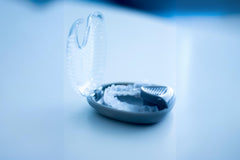Table of contents
-
Underbite: Can You Fix It Without Underbite Surgery?
-
Underbite: A Brief Overview
-
Does My Underbite Require Treatment?
-
Treatment Options for Underbite
-
Underbite Surgery Before and After
-
Underbite Surgery Cost
-
Underbite Surgery Recovery
-
Class 3 Underbite Surgery
-
Does Underbite Surgery Hurt?
-
Clear Aligner Treatment for Underbite
-
Benefits of Using ALIGNERCO’s Clear Braces to Treat Underbite
-
An Affordable Treatment
-
Treat Your Underbite from the Convenience of Home
-
Avoid Oral Surgery
-
Long-term Results
-
Cosmetic Benefits
-
Treat Your Underbite Using ALIGNERCO’s Clear Braces
An underbite is more than a cosmetic concern. When the lower jaw protrudes past the upper jaw, the resulting condition can lead to speech and chewing difficulties.
Some extreme cases may require corrective surgery. Many patients can enjoy relief from an underbite without the need for invasive procedures.
One convenient and cost-effective treatment option uses clear braces to gradually reposition the teeth, which can correct jaw alignment issues. If you have noticed the symptoms of an underbite, this article will explain your treatment options in depth.
Underbite: A Brief Overview
Many people are familiar with the dental alignment problem known as an overbite. Overbite results from the upper row of anterior teeth significantly overlapping the lower row. An underbite results from the opposite problem.
An underbite results from the lower jaw protruding beyond the upper jaw. This dental problem can leave the lower jaw appearing to extend outward in an unattractive position. In many cases, this negatively affects facial symmetry.
An underbite is generally caused by jaw or tooth alignment problems. In some cases, those problems can result from a traumatic injury.
More commonly, underbite results from genetic factors. If one or more of your relatives have a jaw alignment problem, you are more likely to develop an underbite.
Does My Underbite Require Treatment?
While a mild overbite may not require treatment, most forms of underbite do. When the lower jaw protrudes past the upper jaw, the teeth are often unable to align properly. This condition, malocclusion, can lead to a host of serious dental and jaw-related problems.
Individuals with an underbite often experience:
- Difficulty speaking clearly
- Difficulty chewing efficiently
- Jaw pain resulting from an underbite
- Tooth decay
- Gum disease
- Difficulty sleeping
- Mouth breathing
Left untreated, an underbite can lead to serious and uncomfortable jaw conditions. TMJ is one example.
The degenerative jaw condition results from poor jaw alignment. According to Johns Hopkins Medicine, TMJ can result from excessive strain on the jaw joints.
Beyond medical and dental problems that can result from underbite, the dental problem can lead to self-esteem issues. These symptoms often lead patients to explore how to fix an underbite.
Treatment Options for Underbite
Having crowns placed or undergoing other restorative dental treatments can address underbite in some cases. For most patients, teeth straightening or oral surgery can treat an underbite.
Underbite Surgery
An oral surgeon may need to perform surgery if the jaw structure is causing underbite. These are typically considered extreme cases. Only an oral surgeon can recommend surgery as a treatment for underbite.
Dr. Janice Lee described the surgical procedure for a 2019 article published by the National Institutes of Health. The procedure took five hours and required the placement of twenty screws, four plates, and several large bone screws.
As with other major surgeries, general anesthesia is used. Patients can expect side effects like swelling, bruising, and discomfort following surgery.
If the idea of undergoing invasive surgery has you worried, there’s good news. The vast majority of individuals who live with an underbite can treat the condition using non-invasive clear aligners.
Pros and Cons of Underbite Surgery
For patients who have a severe underbite, jaw surgery can provide long-term relief. Patients who require oral surgery are often dealing with the effects of speech impediments and other complications related to a severe underbite. Once recovered, patients who undergo oral surgery do not have to worry about wearing retainers or other corrective devices.
Underbite Surgery Before and After
Understanding the Transformation
Undergoing underbite surgery is a significant decision, often made after careful consideration of both its necessity and impact. The changes brought about by this surgery are not just about enhancing your smile; they involve a fundamental improvement in oral function and facial balance.
Before the Surgery: People living with a pronounced underbite often face challenges beyond cosmetic concerns. The lower jaw extending beyond the upper jaw can lead to difficulties in biting, chewing, and even speaking. It may also cause discomfort and contribute to self-consciousness due to the impact on facial symmetry.
After the Surgery: The transformation post-surgery can be remarkable. The most noticeable change is the realignment of the jaw, which brings the lower and upper jaws into a more natural and harmonious position. This correction improves not only the aesthetic aspect of your smile but also rectifies functional issues. Patients report easier biting and chewing, more comfortable jaw movement, and often a boost in confidence due to the improved facial structure. The surgical correction of the underbite can also alleviate any previously experienced pain or discomfort associated with the condition.
Emotional and Physical Impact: Beyond the physical changes, the emotional and psychological benefits of underbite surgery are profound. Many patients express a newfound sense of confidence and an increased level of comfort in their daily interactions. The journey from pre-surgery to post-surgery is not just a physical transformation but a step towards enhanced overall well-being.

Underbite Surgery Cost
Navigating the Financial Aspects of Underbite Surgery
Underbite surgery, while transformative, comes with a significant financial consideration. The costs can vary widely based on geographical location, the complexity of the case, and the specific healthcare providers involved. Here's a general overview of what you might expect in terms of expenses in different regions. Please note, these figures are approximate and subject to change based on a variety of factors, including insurance coverage and individual provider rates.
| Country | Cost Without Insurance | Cost With Insurance |
|---|---|---|
| United States | $20,000 - $50,000 | Varies based on plan |
| United Kingdom | £8,000 - £15,000 | Varies based on plan |
| Canada | CAD 8,000 - CAD 20,000 | Varies based on plan |
| Australia | AUD 6000 - AUD 17,000 | Varies based on plan |
| Germany | €10,000 - €14,000 | Varies based on plan |
| France | €6,000 - €40,000 | Varies based on plan |
Understanding the Table
- Cost without Insurance: These are broad estimates for the total cost of the surgery without any insurance coverage.
- Cost with Insurance: Costs can significantly vary based on individual insurance plans. Some plans may cover a substantial part of the surgery, especially if deemed medically necessary.
Key Points to Remember
- These figures are indicative and should be used as a rough guide.
- Costs can vary depending on the surgical method, hospital stay, and additional treatments required.
- It's crucial to consult with healthcare providers and insurance companies for precise quotes and coverage details.
- In some cases, payment plans or financial assistance might be available to help manage the costs.
Underbite Surgery Recovery
The Path to Healing Post-Surgery
Recovering from underbite surgery is a critical phase where patience and care are paramount. It's a journey that requires time, and each individual's experience can vary.
Initial Recovery Period: The first few weeks post-surgery are crucial. Patients often experience swelling, bruising, and discomfort. Pain management is essential during this period, and your surgeon will provide guidelines on medication and other relief methods. A liquid or soft diet is typically recommended as the jaw heals.
Follow-Up Visits: Regular check-ups with your surgeon are necessary to monitor the healing process. These appointments are important to ensure everything is progressing as expected and to make any necessary adjustments in your recovery plan.
Follow-Up Visits: Regular check-ups with your surgeon are necessary to monitor the healing process. These appointments are important to ensure everything is progressing as expected and to make any necessary adjustments in your recovery plan.
Long-Term Healing: Complete recovery from underbite surgery can take several months. As you heal, you'll gradually notice improvements in jaw function and appearance. It’s important to follow all post-operative instructions, including oral hygiene practices, to ensure optimal healing.
Emotional and Physical Adjustment: Beyond the physical healing, adjusting to your new jaw alignment can take time. Support from family, friends, and healthcare professionals is crucial during this period for both emotional and physical well-being.
Class 3 Underbite Surgery
Addressing Severe Underbite Challenges
Class 3 underbite, characterized by a significant lower jaw protrusion, often requires a comprehensive surgical approach. This condition not only affects aesthetics but also significantly impacts oral functionality.
Surgical Complexity: Class 3 underbite surgery typically involves more intricate procedures, possibly repositioning both the upper and lower jaws. The goal is to achieve a harmonious bite and improved facial symmetry.
Pre-Surgical Preparation: Before surgery, orthodontic treatment like braces may be necessary to align the teeth properly. This preparatory phase is crucial for the success of the surgery.
The Procedure: Depending on the severity, the surgical procedure can vary. It may involve osteotomies (cutting and realigning jaw bones) and potentially other adjunctive treatments to ensure the best possible outcome.
Expectations and Outcomes: The goal of Class 3 underbite surgery is to improve bite function and facial appearance significantly. Patients typically notice a dramatic difference in their profile and oral functionality post-surgery.
Post-Surgical Care: Recovery from Class 3 underbite surgery follows similar guidelines as other jaw surgeries but may require additional attention due to its complexity. Adhering to your surgeon's instructions is crucial for a successful recovery.
Does Underbite Surgery Hurt?
Underbite surgery is performed under general anesthesia, so there is no pain during the procedure. Post-surgery, patients often experience discomfort as the anesthesia wears off. Pain management is a critical part of the recovery process. Most patients report manageable pain levels, which can be effectively controlled with prescribed pain medications. It's important to follow your surgeon's advice on pain management and report any excessive or prolonged pain.
Clear Aligner Treatment
One common cause of an underbite is tooth misalignment. Malocclusion can cause the jaws to be unable to align snugly when the jaws are closed. This can force the lower jaw forward.
Patients who have this dental problem can benefit from undergoing clear aligner treatment using our convenient clear braces. Traditional metal braces are expensive and can take years to fix an underbite. Our invisible braces can correct an underbite in as few as four months.
Pros and Cons of Clear Aligner Treatment
Treating an underbite using our convenient clear aligners allows our customers to forgo expensive and invasive treatment alternatives. ALIGNERCO’s clear braces can be ordered from the convenience of your home. The treatment is non-invasive, and many of our customers find the process to be comfortable.
Once the treatment is completed, a retainer will need to be worn every night, though. Failure to wear the retainer could lead to tooth shifting.
Which Treatment Is Right for Me?
If you suffer from an extreme underbite that is caused by jaw alignment problems, you may be a candidate for oral surgery.
For the majority of people who have an underbite, though, the dental problem can be addressed using affordable and effective clear aligner treatments. Once we receive your dental impressions, our experts can determine how severe your underbite is. Your custom clear braces will be fabricated to address your underbite symptoms.
Clear Aligner Treatment for Underbite
Maybe you have heard of an underbite treatment that uses clear braces. The first step when undergoing clear aligner treatment is to make an impression.
Impression Kit
Every step of ALIGNERCO’s procedure can be completed from the convenience of your home. Once you receive your impression kit, simply follow the instructions and mail the molds back to one of our offices.
Customized Treatment
One of our team members will use the impressions to customize a treatment plan that addresses your underbite. There’s no need to tell our specialists about your underbite because they are trained to recognize the presence of the jaw alignment issue.
Using Your Clear Aligners
Once your clear aligners arrive at your home, you can begin treatment for underbite immediately. Simply place the trays over your teeth. The aligners will fit snugly.
Each successive tray is slightly straighter. Clear aligners work similarly to braces and gently nudge teeth into better alignment through micromovements. As your teeth move into their ideal position, your jawbone tissue will grow to accommodate the shifting.
After several weeks of treatment, you may begin to see the results. Your lower jawbone will slowly but steadily shift toward a more ideal position as your teeth are repositioned.
As your jaw alignment improves, you can begin to enjoy the benefits of a better bite and clearer speech. Any jaw pain associated with your underbite may begin to recede.
Once your treatment is complete, your underbite will be significantly reduced or altogether eliminated.
Benefits of Using ALIGNERCO’s Clear Braces to Treat Underbite
Most adults and teenagers are eligible for multiple treatment options that can address an underbite. Only ALIGNERCO’s clear aligners can treat underbite quickly and effectively for an affordable price.
An Affordable Treatment
Orthodontic treatment using metal braces can cost several thousand dollars, and the treatment timeline often takes years. Surgery can be considerably more expensive.
Our monthly payment plans start at $81 per month. You can expect the same treatment results.
Treat Your Underbite from the Convenience of Home
Many clear aligner companies require regular visits to the dentist. Traditional orthodontic treatments using metal braces require check-ups for wire tightenings and minor repairs.
ALIGNERCO’s entire treatment process can address underbite without the need for a visit to the dentist. This saves you time and money.
Avoid Oral Surgery
Oral surgery is an invasive procedure that can require the placement of screws and plates. The procedure can take up to several hours to complete, and there is often a long recovery time associated with oral surgery.
If your jawbones are otherwise healthy, you can forgo uncomfortable and costly oral surgery by using comfortable and cost-effective invisible braces. There is no recovery time associated with undergoing clear aligner treatments.
Long-term Results
Once you have finished using your final tray, you can enjoy the benefits of your new smile indefinitely. Simply wear your retainer every night to ensure that your teeth do not shift while you are sleeping.
Cosmetic Benefits
As your teeth move into better alignment, you’ll notice your smile becoming more attractive. ALIGNERCO clear aligners reposition teeth to correct underbite, and they also fix gaps, crooked teeth, and other cosmetic issues that you may have.
Treat Your Underbite Using ALIGNERCO’s Clear Braces
Many clear aligner companies require regular visits to the dentist. Traditional orthodontic treatments using metal braces require check-ups for wire tightenings and minor repairs.
ALIGNERCO’s entire treatment process can address underbite without the need for a visit to the dentist. This saves you time and money.





















